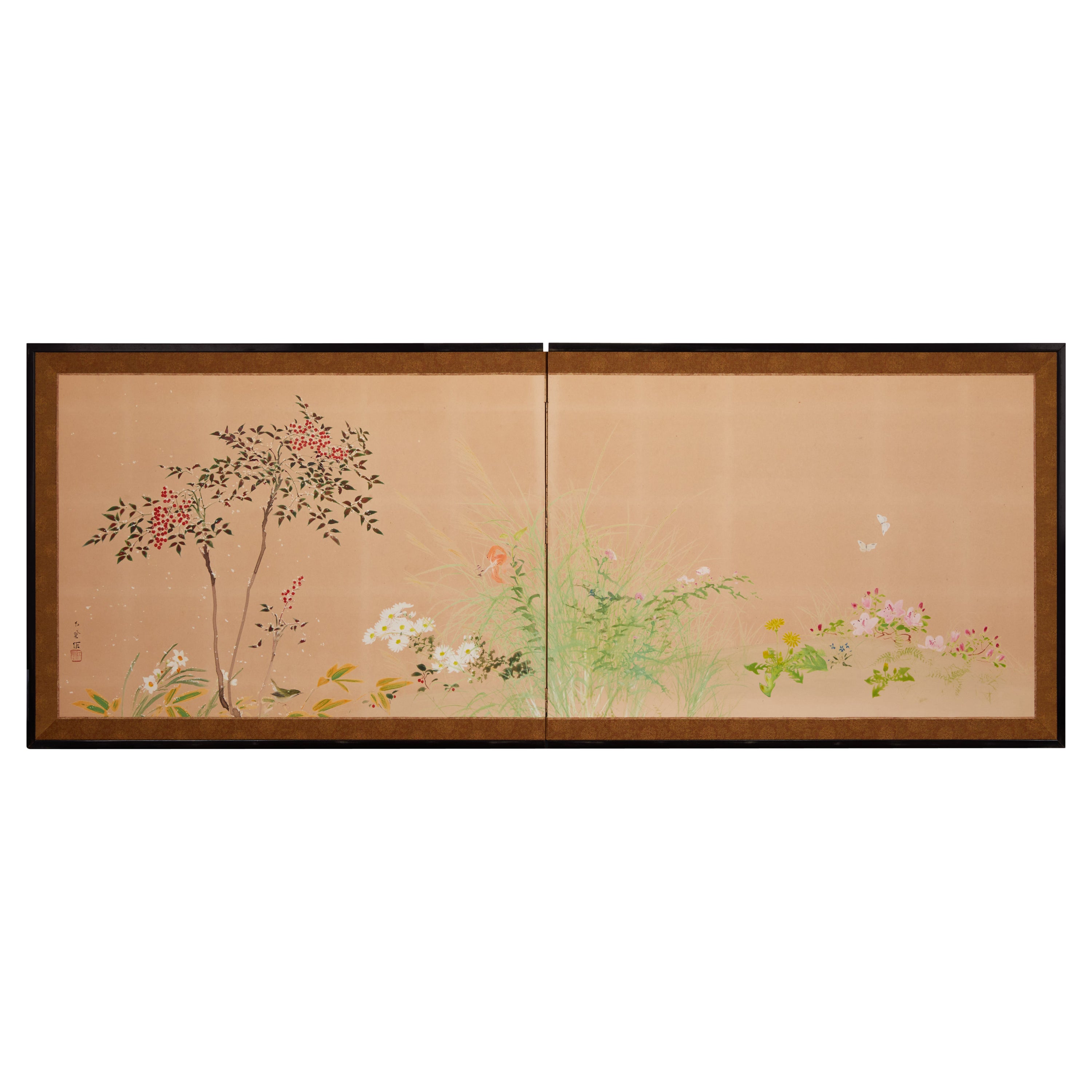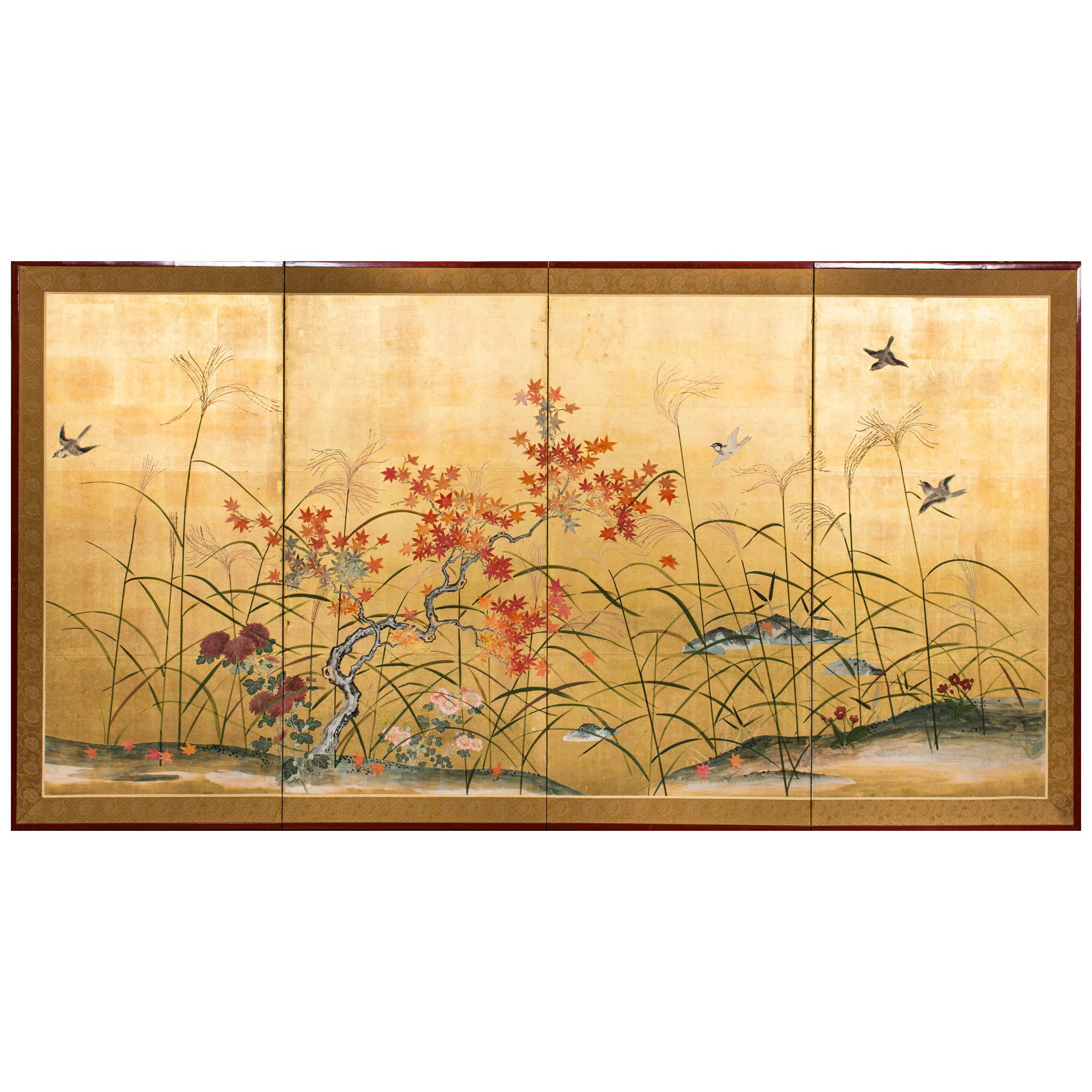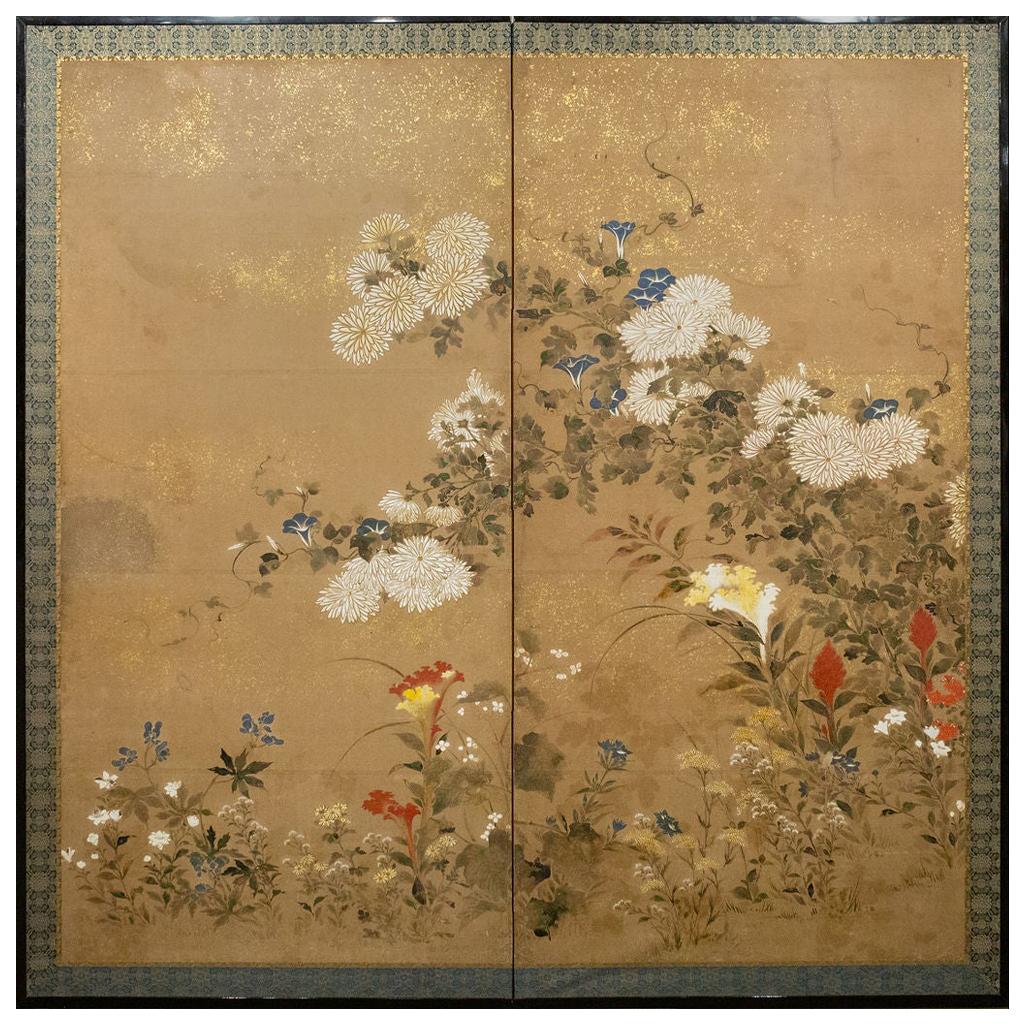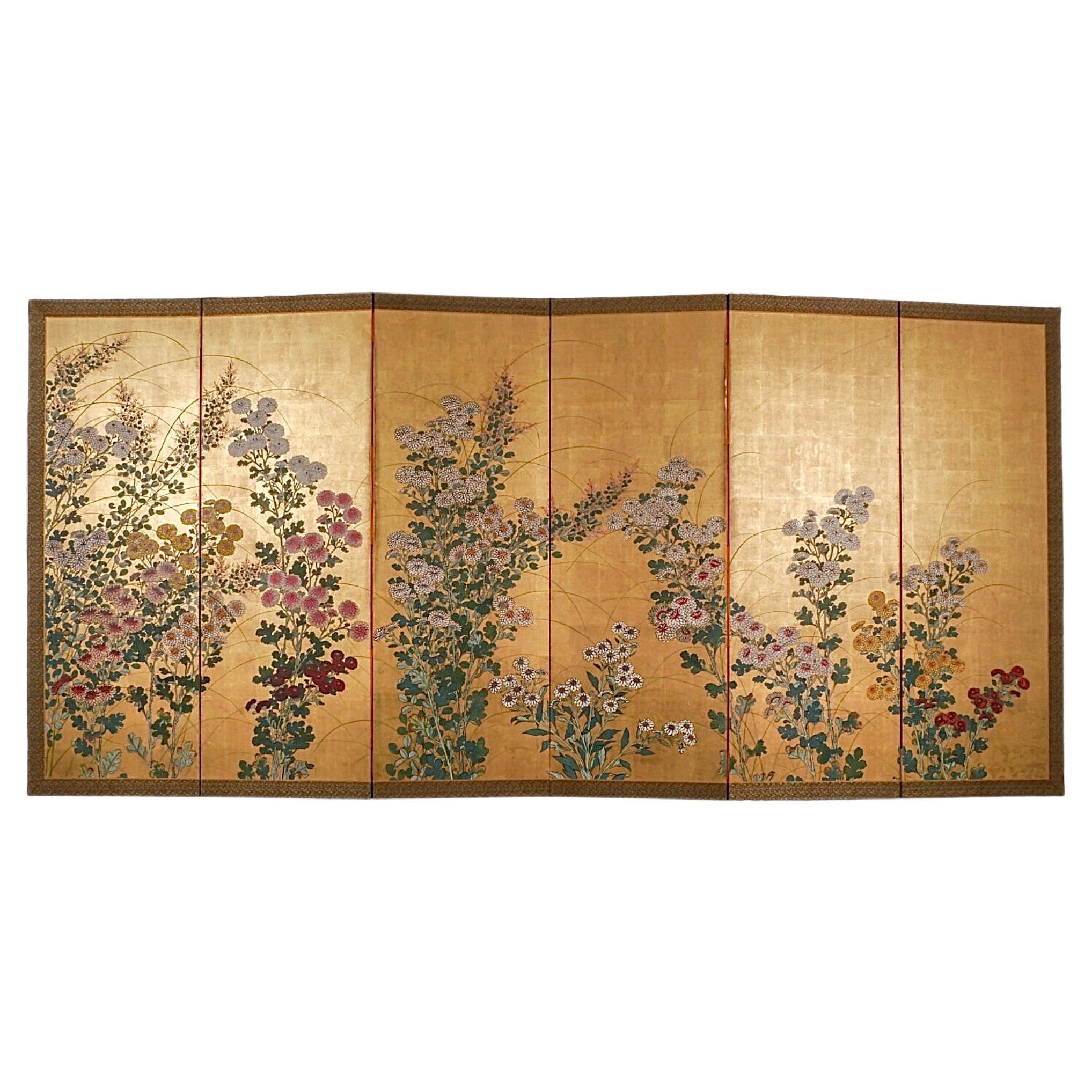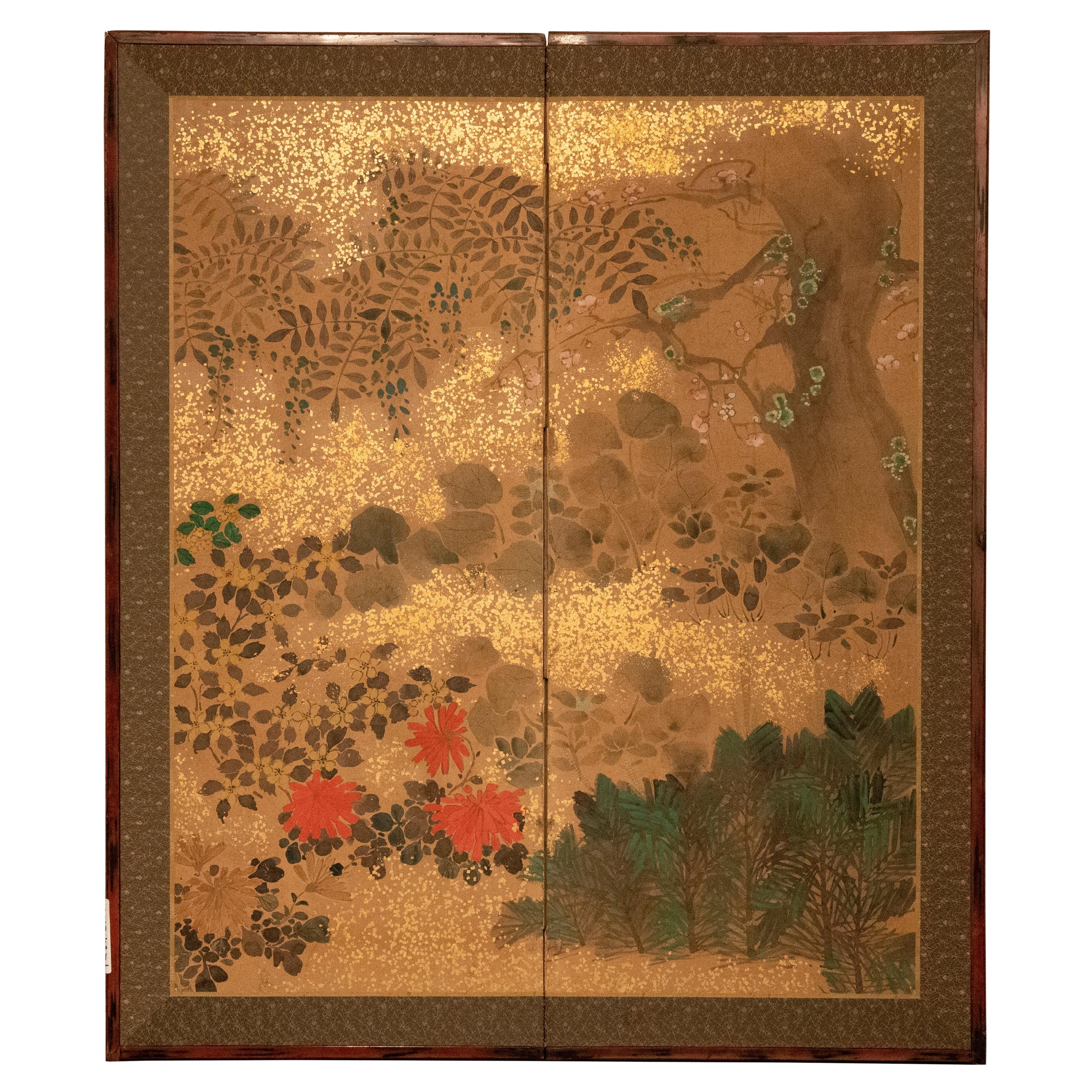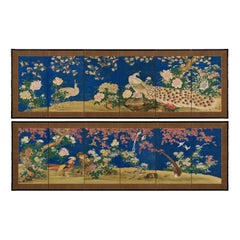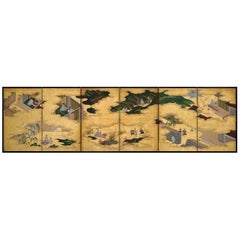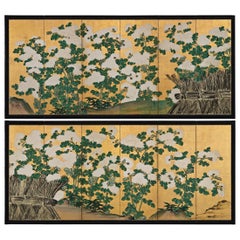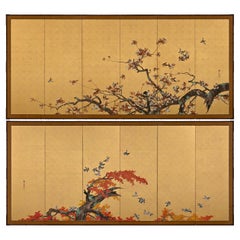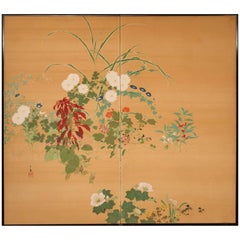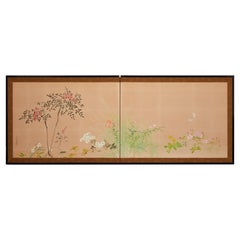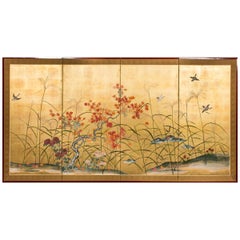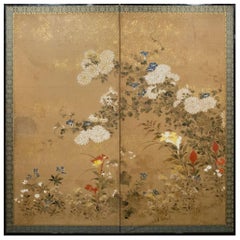Items Similar to Japanese Screen Painting, Early 19th Century, Autumn Flowers by Sakai Hoitsu
Want more images or videos?
Request additional images or videos from the seller
1 of 5
Japanese Screen Painting, Early 19th Century, Autumn Flowers by Sakai Hoitsu
$34,500
£26,177.81
€29,931.98
CA$48,187.14
A$53,577.55
CHF 27,975.24
MX$652,169.23
NOK 356,951.88
SEK 334,446.85
DKK 223,387.88
Shipping
Retrieving quote...The 1stDibs Promise:
Authenticity Guarantee,
Money-Back Guarantee,
24-Hour Cancellation
About the Item
A two-fold Japanese screen by the Rimpa school artist Sakai Hoitsu (1761-1828), Japan, 19th century, Edo period.
This small Japanese folding screen painted by Sakai Hoitsu was originally designed as a pair of sliding doors for an alcove or tokonoma. The scene depicts an autumn vine weaving rhythmically through bellflowers (kikyo) and pampass grass (susuki). Kikyo and susuki are two of the celebrated seven grasses of autumn (aki no nanakusa) which were often mentioned in verses of the Manyoshu, the earliest collection of Japanese poetry and song. More than flowers of any other season, autumn grasses washed by rain and bent in the wind are thought to attain a beauty unsurpassed; many feel the same way regarding Hoitsu’s exquisite brushwork and graceful compositions.
A four-fold screen by Hoitsu utilising the almost identical composition is held in the collection of the Miho Museum, Shiga.
Born into the family of the feudal lords of Himeji castle, Sakai Hoitsu had a privileged and cultivated upbringing providing him the opportunity to study Noh drama, haiku poetry, tea-ceremony, music and painting. As was common during the Edo period, Hoitsu began his study of painting with the officially sanctioned Kano school, later receiving influence from and instruction in the contemporary Ukiyo-e, Maruyama-Shijo and Nagasaki styles. Taking tonsure as a monk in 1797 Hoitsu freed himself of his significant familial obligations and immersed himself in the study of the life and art of Ogata Korin (1658-1716). His attraction to Korin was inspired by the fact that a century earlier Hoitsu’s family had been among Korin’s chief patrons, and numerous masterpieces by Korin were preserved in their collection.
In 1815, 100 years after Korin’s death, Hoitsu published Korin Hyakuzu (One Hundred Paintings by Korin), woodblock print reproductions of paintings by the master. Besides honouring Korin in this way, he clearly traced the lineage of what would come to be known in a later age as the Rinpa (Rimpa) school. Hoitsu, while taking Korin’s works as his model, went on to create highly affecting works reflective of the refined tastes of his day.
In recent times the Rinpa (Rimpa) school, which Hoitsu played a pivotal role in developing, has become Japan’s most admired and celebrated school of art.
In 1972 an exhibition entitled ‘Rinpa’ was held to celebrate the 100th anniversary of the Tokyo National Museum.
Commenting on that exhibition the noted scholar James Cahill states “The world of Rinpa is not far from our everyday life. It simply transforms the everydayness into a thoroughly beautiful image. Of all the arts in the world, if one were to cite a decorative style that transcends the ‘simply decorative’ limit, it would be Rinpa. The delicacy, boldness, and impressiveness of Rinpa is a perfect match for works of religious or humanistic content demonstrating highly refined artistry.”
In 2008 the Tokyo National Museum held an exhibition titled ‘Treasures by Rinpa Masters - Inheritance and Innovation’ in which many works by Hoitsu were featured.
In 2011 to celebrate the 250th anniversary of Hoitsu’s birth a broad and scholarly exhibition titled ‘Sakai Hoitsu and Edo Rinpa’ was held at the Himeji City Museum of Art and the Chiba City Museum of Art.
In 2012 the Japan Society held the exhibition ‘Silver Wind: the Arts of Sakai Hoitsu’ in New York. The exhibited works were sourced predominantly from American collections.
In 2015 the Kyoto National Museum held the blockbuster exhibition ‘Rinpa - The Aesthetics of the Capital’. Works by Hoitsu formed a significant part of the exhibition.
Works by the artist can be found in the collections of: Asia Society, New York; Cleveland Museum of Art, Ohio; Etsuko and Joe Price Collection, USA; Feinberg Collection, USA; Gitter-Yellen Collection, USA; Hosomi Museum, Kyoto; Idemitsu Museum of Arts, Tokyo; Indianapolis Museum of Art, Indiana; Kyoto National Museum; Los Angeles County Museum of Art, California; Metropolitan Museum of Art, New York; Minneapolis Institute of Art, Minnesota; Mitsui Memorial Museum, Tokyo; MOA Museum of Art, Shizuoka; Museum of Fine Arts, Boston; Museum of Imperial Collections, Sannomaru Shozokan; Museum Yamato Bunkakan, Nara; National Gallery of Victoria, Australia; Nelson-Atkins Museum of Art, Missouri; New Orleans Museum of Art, Louisiana; Philadelphia Museum of Art, Pennsylvania; Seikado Bunko Art Museum, Tokyo; Smithsonian Museum of Art, Washington D.C.; Tokyo National Museum; Victoria and Albert Museum of Art, London; Worcester Art Museum, Massachusetts; Yamatane Museum of Art, Tokyo.
Dimensions:
Image H 13” x W 51” (32 cm x 129 cm)
Screen H 18” x W 56” (46 cm x 144 cm).
- Dimensions:Height: 18 in (45.72 cm)Width: 56 in (142.24 cm)Depth: 1 in (2.54 cm)
- Style:Edo (Of the Period)
- Materials and Techniques:
- Place of Origin:
- Period:
- Date of Manufacture:circa 1820
- Condition:Repaired. Refinished. Minor losses. Restored and remounted in Kyoto utilizing traditional craftsmen and materials.
- Seller Location:Kyoto, JP
- Reference Number:1stDibs: LU2472319236992
About the Seller
5.0
Recognized Seller
These prestigious sellers are industry leaders and represent the highest echelon for item quality and design.
Established in 2001
1stDibs seller since 2016
70 sales on 1stDibs
Typical response time: 6 hours
- ShippingRetrieving quote...Shipping from: Kyoto, Japan
- Return Policy
Authenticity Guarantee
In the unlikely event there’s an issue with an item’s authenticity, contact us within 1 year for a full refund. DetailsMoney-Back Guarantee
If your item is not as described, is damaged in transit, or does not arrive, contact us within 7 days for a full refund. Details24-Hour Cancellation
You have a 24-hour grace period in which to reconsider your purchase, with no questions asked.Vetted Professional Sellers
Our world-class sellers must adhere to strict standards for service and quality, maintaining the integrity of our listings.Price-Match Guarantee
If you find that a seller listed the same item for a lower price elsewhere, we’ll match it.Trusted Global Delivery
Our best-in-class carrier network provides specialized shipping options worldwide, including custom delivery.More From This Seller
View AllMid 19th Century Japanese Screen Pair. Flowers & Birds of the Four Seasons.
Located in Kyoto, JP
Shioka Sorin (1781-1850)
Flowers & Birds of the Four Seasons
Pair of six-panel Japanese Screens. Ink, gofun and pigments on silk.
Dimensions (each screen): H. 91.5cm x W. 285cm (3...
Category
Antique Mid-19th Century Japanese Edo Paintings and Screens
Materials
Silk
Japanese Screen Painting, Circa 1700 'Tales of Ise' by Tosa Mitsusuke
By Tosa Mitsusuke 1
Located in Kyoto, JP
A six-fold Japanese screen by Tosa Mitsusuke (1675-1710), Japan 17th-18th century, Edo period.
The signature reads Shoroku-i ge Tosa sa Konoe Shogen Mit...
Category
Antique Late 17th Century Japanese Edo Paintings and Screens
Materials
Gold Leaf
Mid-18th Century Japanese Screen Pair, One Hundred Flowers, Chrysanthemums
Located in Kyoto, JP
Omori Soun (b. 1704)
Chrysanthemums - One Hundred Flowers
A Pair of Six-fold Japanese Screens. Ink, color, gofun and gold leaf on paper.
Dating ...
Category
Antique Mid-18th Century Japanese Edo Paintings and Screens
Materials
Gold Leaf
Meiji Era, Circa 1900 Japanese Screen Pair, Flowers & Birds of Spring & Autumn
Located in Kyoto, JP
Flowers & Birds of Spring and Autumn
Unknown artist.
Japan. Meiji period, circa 1900.
A pair of six-fold screens. Ink, color, gofun and gold leaf on paper.
Signed: Gaga S...
Category
Antique 1890s Japanese Meiji Paintings and Screens
Materials
Gold Leaf
19th Century Japanese Screen Pair. Flowers & Birds of the Four Seasons
Located in Kyoto, JP
Flowers & Birds of the Four Seasons
Pair of six-fold Japanese Screens. Ink, color, gofun and gold on paper.
Second half of the 19th Centur...
Category
Antique Late 19th Century Japanese Meiji Paintings and Screens
Materials
Wood, Paper
Early 20th Century Japanese Cherry Blossom Screen by Kano Sanrakuki
Located in Kyoto, JP
Cherry Blossoms
Kano Sanrakuki (1898-1981)
Showa period, circa 1930
2-panel Japanese Screen
Color, gofun and gold leaf on paper
Against a backdrop of gold-leafed ground, the lichen covered trunk and branches of the life-sized cherry blossom tree reach out and beyond the confines of the pictorial surface. The overall composition has a feeling of flatness which draws emphasis to the surface and the three-dimensionality of the cherry blossoms. Painstakingly built-up layers of thickly applied shell-white gofun detail the voluminous blossoms and cover large areas of this tour-de-force of Japanese Nihonga painting. By simplifying the background, minimizing the number of colors and depicting the blossoms with such heavy relief, the artist has emphasized the stunning presence of the cherry tree. The type of tree depicted is the Yae-Zakura; a double-layered type of cherry blossom famed for its beauty and strength. When we think of Japanese cherry blossoms, the first thing that comes to mind is Somei Yoshino variety, which has a single flower with five almost white petals. This type is fragile and easily blown away by strong wind or rain. Most of the double-flowered cherry blossoms begin to bloom when the Somei-Yoshino falls, and the flowering period lasts longer than that of the Somei-Yoshino.
Kano Sanrakuki originally studied painting at the Kyoto City Arts and Crafts School under the tutelage of Yamamoto Shunkyo...
Category
Early 20th Century Japanese Showa Paintings and Screens
Materials
Gold Leaf
You May Also Like
Japanese Two-Panel Screen, Summer Flowers on Silk
Located in Hudson, NY
Rimpa painting of flowers including morning glories, hollyhocks, sweet peas, nadeshiko, and daisies. Signature and seal read: Bisui
Category
Antique Late 19th Century Japanese Meiji Paintings and Screens
Materials
Silk, Wood
Japanese Two Panel Screen: Winter into Spring Floral Landscape
Located in Hudson, NY
With nandin, narcissus and chrysanthemums. Signature and seal read: Koun. Mineral pigments on mulberry paper with a silk brocade border.
Category
Early 20th Century Japanese Paintings and Screens
Materials
Brocade, Silk, Paper
Japanese Four Panel Screen, Autumn Flowers
Located in Hudson, NY
Taisho period painting (1912-1926) of a fall landscape with wild grasses, red maple, and dahlias. Mineral pigments on gold with a silk brocade border and beautiful metal mounts.
Category
Vintage 1920s Japanese Taisho Paintings and Screens
Materials
Silk, Wood, Paper
Japanese Two-Panel Screen, Flower Garden
Located in Hudson, NY
Rimpa School painting featuring cascading chrysanthemums as well as cockscombs, summer wild flowers, and a climbing morning glory vine. Beautifully executed, fine painting in mineral...
Category
Antique Mid-18th Century Japanese Edo Paintings and Screens
Materials
Gold Leaf
Japanese Six-Panel Screen Byobu With Chrysanthemums And Autumn Grass and Flower
Located in Torino, IT
The 19th Century Six-Panel Japanese folding screen "Byōbu" usually used in the most important Japanese house to stop wind and also to separate different space of the same big room de...
Category
Antique Mid-19th Century Japanese Edo Paintings and Screens
Materials
Gold Leaf
Japanese Two Panel Screen: Rimpa Flowers
Located in Hudson, NY
with gold flake design. Mineral pigments on mulberry paper, with silk brocade border, and red negoro style lacquer trim.
Category
Early 20th Century Japanese Paintings and Screens
Materials
Gold
More Ways To Browse
19th Century Flower Paintings
Antique Japanese Screens
Asian Silk Screens And Paintings
Silk Screen Paintings
Japanese Weaving
Antique Reproduction Paintings
Japanese Silk Screen Painting
Antique Silk Screen Painting
19th Century Japanese Screen
Pair Of Japanese Paintings
Japanese Furniture Los Angeles
Japanese Monk
Used Screen Doors
Japanese Folding Screens
18 Century Reproductions
Decorative Folding Screens
Japanese Screen Silver
Japanese Screens Flowers

